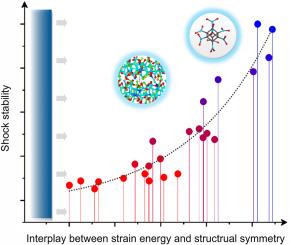笼状聚氮立方高能量密度材料的冲击响应:应变能与结构对称的竞争
IF 3.9
Q2 CHEMISTRY, MULTIDISCIPLINARY
引用次数: 0
摘要
这种笼状结构提供了一种独特的应变能组合,增强了能量存储,并通过超静约束来稳定系统,使其成为推进高能量密度材料(hedm)的有前途的先驱。然而,笼状hedm的冲击反应非常复杂,表现出显著的可变性,这对其潜在机制提出了巨大的挑战。本研究揭示了笼状HEDMs的冲击响应是由应变能和结构对称性之间的相互作用所调节的,并引入了一个物理模型来定量描述它们如何决定冲击稳定性。所研究的体系包括一系列全面的笼状多硝基立方化合物,主链上的每个碳原子都逐渐被硝基官能团化。采用从头算分子动力学(AIMD)模拟了在8 km·s−1至11 km·s−1激波速度范围内的动力学和动力学响应,并通过与实验数据一致的Hugoniot曲线进行了验证。碳基笼状结构中的硝基被认为是爆炸官能团,可以显著提高体系的应变能。然而,越来越多的硝基也加剧了氧孤对之间的静电斥力,这削弱了结构的完整性,使材料在冲击条件下更容易拆卸。相反,结构对称——包括笼状分子构象和晶格内的空间填充——被发现可以减轻这些不稳定效应,有效地平衡能量储存和结构稳定性之间的权衡。基于这些发现,我们提出了一个物理模型,该模型捕捉了驱动笼状多硝基氯苯hedm中冲击启动的基本因素,为新型先进hedm的设计和应用提供了新的见解。本文章由计算机程序翻译,如有差异,请以英文原文为准。

Shock response in cage-like polynitrocubane high-energy-density materials: Competition between strain energy and structural symmetry
The cage-like structures provide a unique combination of strain energy for enhanced energy storage and hyperstatic constraints to stabilize the system, positioning them as promising pioneers in advancing high-energy-density materials (HEDMs). However, the shock response of cage-like HEDMs is highly complex and exhibits significant variability, posing a grand challenge in the underlying mechanisms. This study reveals that the shock response of cage-like HEDMs is regulated by the interplay between strain energy and structural symmetry, and introduces a physical model to quantitatively describe how they determine shock stability. The investigated systems include a comprehensive series of cage-like polynitrocubane HEDMs, with each carbon atom in the backbone progressively functionalized with nitro groups. Ab initio molecular dynamics (AIMD) simulations were employed to simulate dynamic and kinetic responses at shock velocities ranging from 8 km·s−1 to 11 km·s−1, with validation provided by consistent Hugoniot curves that align with reported experimental data. Nitro groups at the carbon-based cage structure, recognized as explosion functional groups, were found to substantially increase the system's strain energy. However, an increasing number of nitro groups also intensified electrostatic repulsion among oxygen lone pairs, which weakens structural integrity and renders the material more susceptible to disassembly under shock conditions. Conversely, structural symmetry—including both the cage-like molecular conformation and spatial packing within the crystal lattice—was found to mitigate these destabilizing effects, effectively balancing the trade-off between energy storage and structural stability. Based on these findings, we propose a physical model that captures the essential factors driving shock initiation in cage-like polynitrocubane HEDMs, offering new insights to inform the design and application of novel advanced HEDMs.
求助全文
通过发布文献求助,成功后即可免费获取论文全文。
去求助
来源期刊

Energetic Materials Frontiers
Materials Science-Materials Science (miscellaneous)
CiteScore
6.90
自引率
0.00%
发文量
42
审稿时长
12 weeks
 求助内容:
求助内容: 应助结果提醒方式:
应助结果提醒方式:


